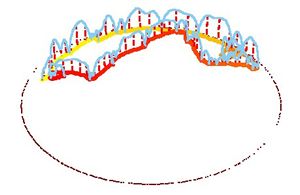
Phenotyping of mouse exploratory behavior
D. Drai1, G. Elmer2, Y. Benjamini3, N. Kafkafi1 and I. Golani1
1Department
of Zoology, Tel Aviv University, Tel Aviv, Israel
2Maryland Psychiatric Research
Center, University of Maryland, Baltimore, MD, U.S.A.
3Department of Statistics
and OR, Tel Aviv University, Tel Aviv, Israel
Behavior genetics relies critically on the comprehensiveness and accuracy of the measured phenotype in terms of its reliability and relevance. The need for such phenotyping has resulted in the design of batteries of behavioral and physiological tests. A central component listed in most test batteries is open field behavior (exploratory behavior, locomotor behavior in the open field). The variables recorded in this test typically include the cumulative distance covered by the mouse during a session, the ratio between staying in the periphery and center of the arena, activity decrement upon repeated exposures to spatial novelty, and the frequency of rearing, of sniffing, and of defecating. These measures are all cumulative and general, reflecting the common view that open-field behavior is largely stochastic in nature. In recent years, however, more detailed studies of rat exploratory behavior (ExB), done in our lab and by others, revealed that rat ExB consists of typical behavioral patterns with a distinct structure. Recently we have developed interactive software for analyzing this structure. This software is able to visualize and quantify the patterns of ExB, using as input the automatically digitized time-series of the animal's location. Preliminary results which will be presented in the conference will suggest that a considerable number of rat ExB patterns are also present in the mouse, and they have a significant potential as a phenotyping tool. We will thus propose in our presentation to augment the commonly used measures of the open field test with a set of new, ethologically relevant parameters. These parameters are relatively independent of each other and reveal a natural structure that is relatively independent of the level of activity. They reflect processes involving motivation, navigation, spatial memory and learning. They can be measured automatically and efficiently, using setups and hardware that are already in use in many laboratories. In order to control the false discovery rate inherent in multiple testing procedures we rely on the FDR method developed by Benjamini and Hochberg. This study may promote a quantitative approach to the study of behavior patterns. It might also encourage interdisciplinary research between the fields of behavioral neurogenetics, ethology and cognitive psychology.

Figure 1. A phase space representation of an excursion of a BALB/cJtau male from home base and back to it. The time course is coded by the color (yellow = start, red= end), and velocity is represented in azure in the third dimension. For ease of interpretation, the red dashed lines show the projection of some values of velocity on the plane of the path. The frequent short stops (velocity graph touching path on ground) characterize BALB/cJtau locomotor behavior.
In a project now being carried out in our respective laboratories we plan to:
This project is supported by NIH grant 1 R01 NS40234-01.
Poster presented at Measuring Behavior 2000, 3rd International Conference on Methods and Techniques in Behavioral Research, 15-18 August 2000, Nijmegen, The Netherlands
© 2000 Noldus Information Technology b.v.